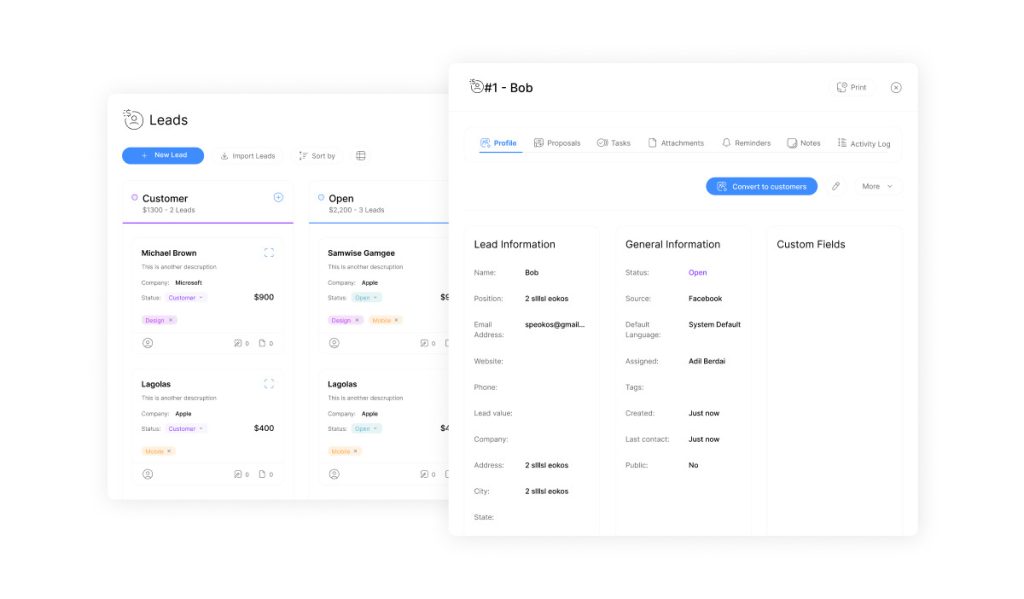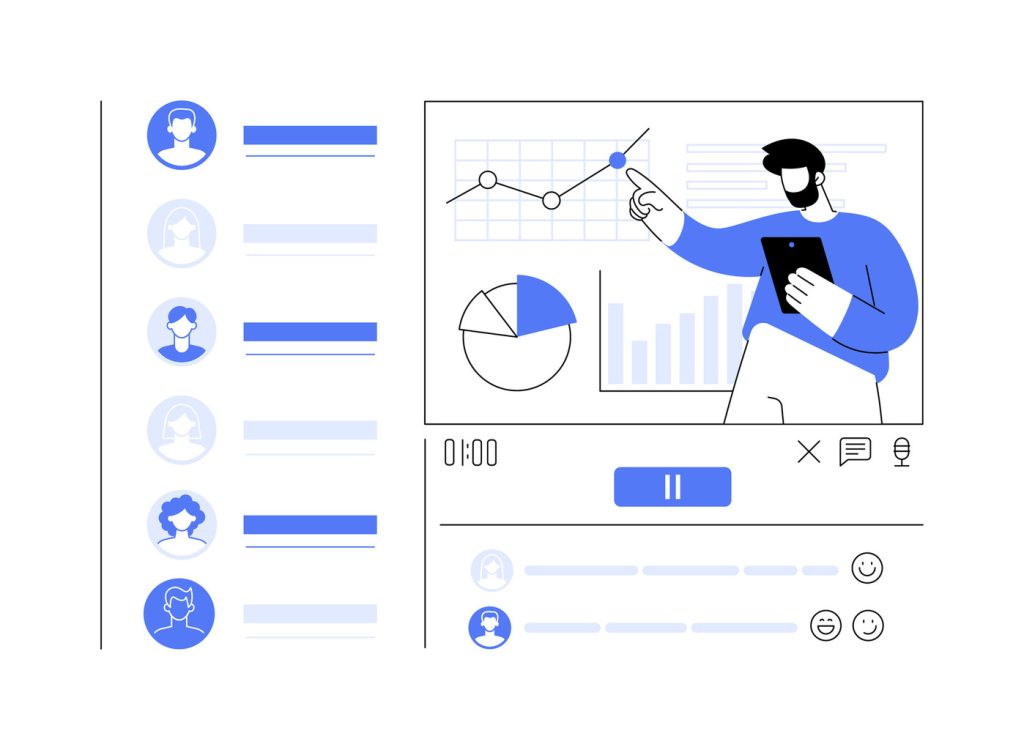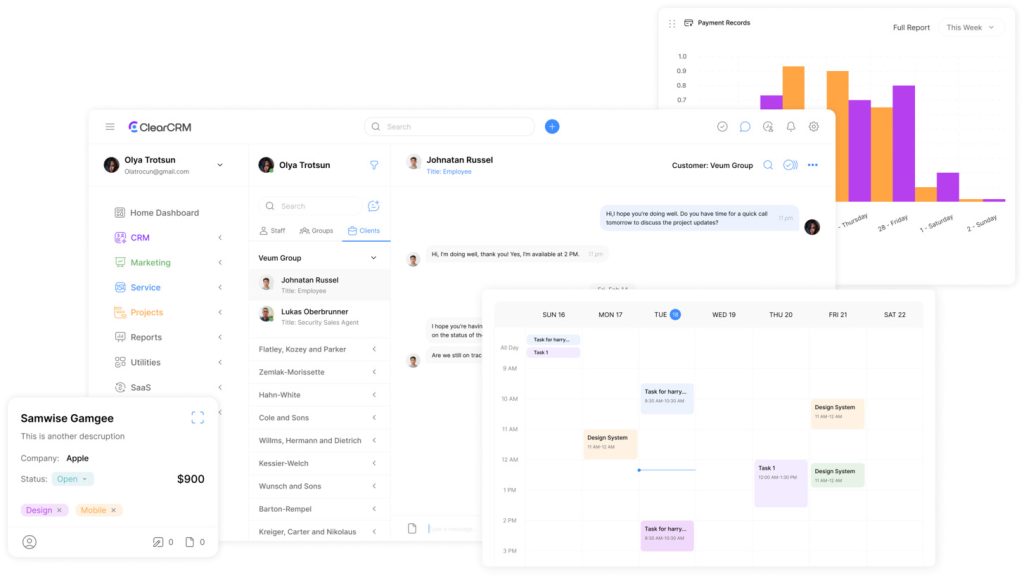Customer Profile Management: Best Practices for Success

In today’s competitive market, leveraging data-driven strategies is no longer optional. According to Zendesk and Gartner, 59% of consumers expect personalized interactions shaped by accurate insights. This demand makes effective client information management with ClearCRM a cornerstone of modern business success.
Centralizing data allows teams to unify interactions across sales, marketing, and support. For example, integrated systems reduce friction in the client journey, ensuring seamless transitions between departments. When teams share a single source of truth, they can anticipate needs faster and deliver tailored solutions.
Research shows businesses that prioritize organized client insights see higher retention rates. Streamlined processes minimize redundancies, freeing resources for innovation. This approach also builds trust, as consistency fosters loyalty in an era where personalization drives decisions.
The following sections will explore actionable steps to refine data collection, improve cross-department collaboration, and scale strategies sustainably. By adopting these practices, organizations can turn raw information into measurable growth.
Key Takeaways
- Personalized experiences drive 59% of consumer expectations, per Zendesk and Gartner.
- Unified data systems eliminate silos and simplify client journeys.
- Centralized insights boost retention by enabling proactive service.
- Efficient processes reduce operational costs and accelerate decision-making.
- Cross-functional collaboration ensures consistency across touchpoints.
Overview of Customer Profile Management

Understanding individual preferences drives modern business growth. A client profile acts as a detailed blueprint, combining demographics, behavior patterns, and challenges. These insights allow brands to craft interactions that resonate deeply, much like music apps curate playlists by analyzing listening habits.
What Makes a Powerful Client Profile?
Effective profiles go beyond basic details. They include:
- Demographics: Age, location, or income brackets
- Behavioral trends: Purchase history or engagement frequency
- Challenges: Specific obstacles clients aim to overcome
For instance, streaming platforms use such data to suggest tracks aligned with users’ moods. Similarly, businesses can predict needs before clients articulate them.
Advantages of Strategic Profiling
Organizations using these tools see measurable improvements. Targeted campaigns achieve conversion rates 2.5 times higher than generic outreach. Retention also climbs when solutions address specific pain points proactively.
“Profiling transforms raw data into actionable roadmaps for relevance.”
Teams collaborate more effectively with unified insights, ensuring messaging remains consistent across channels. This alignment reduces resource waste while amplifying campaign impact.
The Importance of Customer Profile Management for Business Success

Businesses thriving in the digital age recognize that detailed client insights are the backbone of strategic decision-making. With 59% of consumers expecting interactions tailored to their preferences—as highlighted by Zendesk—organizations can’t afford generic approaches. Gartner reinforces this, noting that data-driven strategies directly influence revenue growth and market differentiation.
Robust profiling unlocks three critical advantages:
- Laser-focused targeting: Analyzing behaviors and preferences reveals patterns, enabling campaigns that resonate 2.5x better than broad outreach.
- Operational efficiency: Unified data systems eliminate redundant tasks, freeing teams to innovate rather than reconcile inconsistencies.
- Trust-building consistency: When sales, support, and marketing share accurate insights, interactions feel cohesive—a key driver of loyalty.
Take streaming giants like Spotify. By tracking listening habits, they craft personalized playlists that keep users engaged. Similarly, e-commerce brands use purchase histories to suggest products aligned with individual tastes. These efforts hinge on integrated systems that break down silos between departments.
“Companies leveraging enriched profiles see 40% faster decision-making and 35% higher campaign ROI,”
Aligning these efforts with broader business goals ensures scalability. For example, a retail chain might link profiling to inventory planning, ensuring popular items stay stocked in regions where demand peaks. This synergy turns raw information into actionable intelligence—proving that precision drives profit.
How to Build a Customer Profile Step-by-Step
Constructing detailed client profiles requires a methodical approach to transform raw data into actionable strategies. Start by gathering insights through ethical, transparent methods that respect privacy while uncovering critical patterns.
Collecting and Analyzing Customer Data
Effective data collection blends quantitative metrics and qualitative feedback. Use these tools:
- Surveys: Short, targeted questions reveal preferences and challenges.
- CRM systems: Track interactions across sales, support, and marketing.
- Social listening: Monitor online conversations to detect emerging trends.
| Tool | Data Type | Key Benefit |
|---|---|---|
| Email Surveys | Direct feedback | High response rates |
| CRM Analytics | Behavioral trends | Real-time updates |
| Social Platforms | Sentiment analysis | Unfiltered opinions |
Combine numerical data—like purchase frequency—with open-ended responses to identify gaps. For example, a retail brand might correlate survey complaints about delivery times with CRM logistics records.
Identifying Customer Pain Points
Spotting recurring frustrations requires systematic analysis. Follow these steps:
- Review support tickets and reviews for common themes.
- Categorize issues by urgency and impact on satisfaction.
- Prioritize solutions that align with business capabilities.
“Teams that map pain points to operational workflows reduce resolution times by 40%,” notes HubSpot’s 2023 service trends report.
For instance, a SaaS company might discover users struggle with feature navigation through session recordings. Simplifying the interface based on this insight could boost retention by 25%.
Accurate data gathering ensures profiles reflect real needs. Pair metrics like churn rates with direct interviews to build holistic views. This dual approach turns fragmented information into strategic assets.
Effective Customer Profile Management Strategies
Businesses that master client insights unlock exponential growth opportunities. Advanced profiling strategies turn fragmented data into cohesive roadmaps, driving engagement and revenue. Here’s how leading organizations elevate their approach.
Tailoring Personalized Experiences
Dynamic CRM workflows help teams automate and personalize client engagement at scale. For example, e-commerce brands use browsing history to trigger product recommendations in emails. A fitness app might adjust workout plans based on user progress tracked in their system.
Proactive support also builds loyalty. One telecom company reduced churn by 18% after analyzing service tickets to predict account issues. Agents then reached out with tailored solutions before clients contacted them. By investing in top customer support software options that leverage data analytics and machine learning, businesses can gain deeper insights into customer behavior and potential pitfalls. This preemptive approach not only enhances the customer experience but also fosters a stronger relationship between the brand and its clients. As a result, companies can enjoy increased customer retention and a more sustainable growth trajectory.
Segmenting Your Audience Effectively
Strategic grouping sharpens campaign precision. Consider these criteria:
| Segment | Strategy | Outcome |
|---|---|---|
| High-spenders | Exclusive early access | 35% repeat purchases |
| Inactive users | Re-engagement discounts | 22% reactivation rate |
Email campaigns segmented by engagement levels achieve 30% higher open rates. A travel agency using location-based offers saw bookings rise by 40% in targeted regions.
“Segmentation isn’t just grouping; it involves predicting needs before they’re voiced.”
Platforms like Netflix demonstrate this. By categorizing viewers by genre preferences, they drive binge-watching behavior through hyper-relevant content suggestions.
Combining behavioral data with demographic insights ensures messaging resonates. For instance, a skincare brand tailored product bundles for dry vs. oily skin types, boosting average order values by 27%.
Tools and Platforms for Collecting Customer Data

Modern businesses rely on precise data collection tools to fuel growth. Advanced platforms transform scattered details into actionable insights, enabling teams to deliver tailored products and services. By integrating these solutions, organizations eliminate guesswork and base decisions on real-time information.
CRM Systems and Their Advantages
Centralized platforms like Salesforce or HubSpot consolidate customer data from emails, calls, and purchases. This creates a unified view of interactions across departments. Sales teams track leads, while support agents access purchase histories to resolve issues faster.
| Platform | Data Collected | Key Benefit |
|---|---|---|
| Salesforce | Purchase history, communication logs | Predictive analytics for sales trends |
| Zoho CRM | Website behavior, support tickets | Automated workflow triggers |
These systems update profiles automatically, ensuring teams always work with current information. Marketing departments use this data to segment audiences for campaigns with 30% higher open rates.
Utilizing Social Media and Analytics Tools
Platforms like Sprout Social track brand mentions and sentiment across social media channels. This reveals unmet needs or emerging trends. For example, a spike in negative posts about delivery delays could prompt logistics improvements.
Email tools like Mailchimp combine engagement metrics with demographic data to fine-tune campaigns. A/B testing subject lines or content layouts boosts click-through rates by 22%. Combined with CRM data, these insights refine customer profiles continuously.
“Integrating analytics tools cuts campaign adjustment time by 50%,” reports a 2024 MarTech industry study.
Real-time dashboards in platforms like Google Analytics help teams spot trends early. When paired with social media listening, businesses gain a 360-degree view of client preferences and pain points.
Integrating Data for a Unified Customer View

Disconnected data sources create fragmented views that hinder personalized engagement. Unified systems like Zendesk Agent Workspace merge real-time information from emails, chats, and support tickets into one dashboard. This eliminates guesswork, letting teams respond faster with context-rich solutions.
Breaking down internal silos starts with integrating CRM, social media, and sales platforms. When marketing accesses support history, campaigns align with unresolved pain points. Sales teams use purchase patterns to prioritize high-value segments. Collaboration improves as departments share insights instead of guarding spreadsheets.
“Unified data reduces resolution times by 30% while boosting satisfaction scores,” notes Zendesk’s 2024 CX Trends Report.
Effective segmentation groups audiences by behavior, like frequent buyers or cart abandoners. Analyzing these profiles reveals trends—for example, SaaS users who cancel after trial periods may need onboarding guides. Real-time updates ensure teams act on fresh data, not outdated snapshots.
Platforms like Salesforce demonstrate this approach. Their Einstein AI combines transactional records with service interactions to predict churn risks. Retailers using similar tools see 25% higher conversion rates through hyper-targeted offers.
Centralized information transforms reactive service into proactive guidance. Teams spot cross-sell opportunities during support calls or adjust email content based on recent purchases. This agility turns raw data into competitive advantage—one cohesive view at a time.
Leveraging Customer Profiles for Targeted Marketing Success
Accurate audience data turns generic ads into conversion engines. Brands that align campaigns with client insights achieve 45% higher engagement rates than those relying on broad messaging. This precision stems from transforming raw information into actionable marketing blueprints.
Optimizing Marketing Campaigns
Refined segmentation enables hyper-focused outreach. For example, an e-commerce brand might use browsing history to send emails featuring recently viewed items. One retailer saw a 33% lift in click-through rates after implementing this strategy.
Key approaches include:
- Behavior-triggered ads: Display products to users who abandoned carts or searched specific terms
- Demographic layering: Combine location data with purchase patterns for geo-targeted offers
- Preference-based timing: Schedule emails when open rates peak for each segment
| Campaign Type | Segmentation Criteria | Result |
|---|---|---|
| Retargeting | Cart abandoners | 28% conversion boost |
| Upsell | High-spending clients | 19% revenue increase |
“Brands using dynamic profiling see 50% faster campaign adjustments and 37% higher ROI,” notes a 2024 HubSpot marketing report.
Understanding pain points also sharpens messaging. A SaaS company reduced churn by 22% after addressing onboarding frustrations highlighted in client surveys. Real-time analytics allow teams to test variations quickly—A/B testing subject lines or visuals often yields 15-20% performance improvements.
Ultimately, detailed profiles turn marketing into a precision tool. They reveal not just who the ideal audience is, but how to reach them with relevance that converts.
Overcoming Common Challenges in Customer Profile Management

Organizations often face hurdles when refining their approach to client insights. Fragmented data systems and shifting market demands create roadblocks that hinder personalized engagement. Addressing these issues requires strategic adjustments to maintain relevance.
Breaking Down Data Silos
Isolated information repositories slow decision-making. For example, separate sales and support databases lead to inconsistent client histories. A 2024 Forrester study found 63% of businesses lose revenue due to unshared data across teams.
Practical fixes include:
- Adopting unified platforms like Salesforce to merge cross-departmental records
- Establishing clear data ownership policies to ensure accountability
- Running quarterly audits to identify and eliminate redundant tools
One retail chain boosted service efficiency by 40% after integrating their CRM with logistics software. Agents resolved shipping inquiries faster using real-time inventory data.
Adapting to Evolving Consumer Behaviors
Market trends shift rapidly—what worked last quarter might miss today. A streaming platform noticed a 20% drop in engagement when they delayed updating viewer preference algorithms. Regular profile updates prevent such gaps.
“Static insights become liabilities. Dynamic adjustments based on real-time signals are non-negotiable,” states McKinsey’s 2024 CX Innovation Report.
Effective adaptation strategies:
- Monitor social sentiment weekly to detect emerging needs
- Use AI tools like Google Analytics’ predictive modeling to forecast trends
- Train teams to revise outreach tactics based on fresh behavioral data
A tech company reduced churn by 18% after aligning product updates with feature usage patterns. Their updated profiles helped tailor in-app guidance for struggling users.
Proactive refinement turns obstacles into opportunities. When systems and strategies evolve alongside customers, organizations achieve lasting agility in client engagement.
Future Trends in Customer Profile Management
Emerging technologies are reshaping how businesses interpret client needs and forecast demands. Artificial intelligence now processes behavioral patterns at unprecedented speeds, transforming static data into dynamic strategies. This shift enables companies to predict preferences before they fully emerge.
AI-Driven Precision in Decision-Making
Machine learning algorithms analyze vast datasets to identify hidden correlations. Retailers use these insights to adjust inventory based on regional buying habits. Streaming services refine content suggestions by tracking minute-by-minute engagement shifts.
| AI Application | Business Impact | Efficiency Gain |
|---|---|---|
| Predictive analytics | 25% higher conversion rates | Reduces campaign planning time by 40% |
| Chatbot integration | 30% faster query resolution | Cuts support costs by 22% |
| Automated segmentation | 45% email open rate boost | Lowers manual tagging errors by 60% |
Advanced tools like Salesforce Einstein now forecast lifetime value with 89% accuracy. These systems update profiles in real time, ensuring marketing teams always target the most responsive audiences.
“By 2025, AI-powered profiling will drive 70% of all personalization efforts,” predicts Gartner’s 2024 Tech Trends Report.
Product development teams benefit from predictive models that highlight unmet needs. Automotive manufacturers analyze social sentiment to design features aligning with evolving safety priorities. This approach reduces time-to-market by 33% for new models.
Businesses that adopt these innovations gain decisive advantages. Early adopters report 50% faster response to market shifts and 28% higher cross-sell success rates. Continuous adaptation ensures strategies remain relevant as consumer expectations evolve.
Actionable Tips to Get Started with Customer Profile Management
Launching a strategic approach to client insights requires practical steps that align with operational goals. Businesses can implement these five foundational actions to build robust systems quickly:
- Map essential data points—such as purchase history, support interactions, and media engagement—to build a complete profile.
- Use free templates: HubSpot offers downloadable profile blueprints that streamline initial setup.
- Integrate existing tools: Connect CRM platforms with email services and social media analytics.
| Tool | Use Case | Integration Benefit |
|---|---|---|
| Google Forms | Preference surveys | Auto-populates CRM fields |
| Canva | Visual templates | Standardizes data presentation |
| Zapier | Cross-platform sync | Reduces manual entry by 70% |
Regular updates ensure profiles reflect current preferences. Schedule monthly reviews to incorporate new information from service tickets or social media trends. One e-commerce company boosted conversions by 19% after aligning product suggestions with updated browsing data.
“Start small—focus on three critical data points, then expand as systems mature,” advises a Salesforce implementation case study.
For media integration, sync platforms like Hootsuite with CRMs to track brand mentions alongside purchase behavior. This reveals how social sentiment influences buying decisions. Teams can adjust campaigns in real time based on evolving insights.
Prioritize transparency when gathering information. Clearly explain how data improves services, increasing opt-in rates by 33% in one retail chain’s loyalty program. Immediate action on feedback—like resolving shipping delays within 24 hours—builds trust and refines profiles organically.
Conclusion
Mastering client insights separates industry leaders from competitors in today’s data-driven economy. A robust strategy for organizing client details drives measurable results—59% of consumers expect personalized interactions, while targeted campaigns achieve 2.5x higher conversions. Centralized data systems eliminate silos, enabling teams to deliver seamless experiences that build loyalty.
Integrating advanced tools like AI-powered CRMs and social listening platforms sharpens decision-making. Businesses that adopt these solutions see 40% faster campaign adjustments and 35% higher retention rates. Continuous updates ensure profiles reflect evolving preferences, turning raw information into actionable roadmaps. By mastering CRM campaign strategies, organizations can create hyper-targeted messaging that resonates with their audience. This level of personalization not only boosts engagement but also fosters brand loyalty in an increasingly competitive landscape. Ultimately, leveraging these advanced tools positions businesses for sustained growth and success in their marketing initiatives.
Success hinges on proactive adaptation. Regular audits of behavioral trends and operational workflows keep strategies aligned with market shifts. Teams prioritizing dynamic insights reduce resolution times by 30% while boosting satisfaction scores.
Decision-makers must act now. Implement centralized systems, leverage segmentation tools, and refine outreach using real-time analytics. These steps transform fragmented details into cohesive growth engines—proving that precision today fuels profitability tomorrow.

